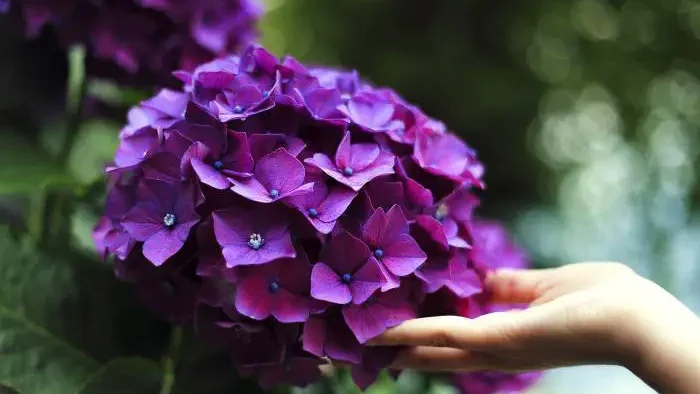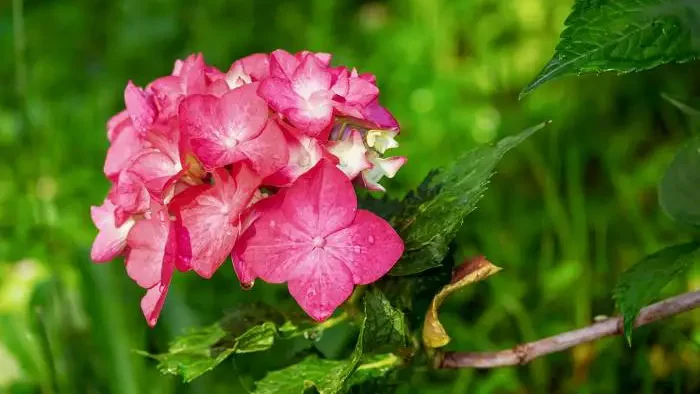Hydrangeas Deadheading – When & How To Do It?

Deadheading is an everyday practice with flowering shrubs. In a nutshell, it means chopping off flower heads.
The process involves removing any fading blooms from your shrubs to allocate energy in the plant toward seed production and new growth.
Deadheading is also recommended because it prevents your shrubs from looking like they are dying off.
Some plants benefit from deadheading more than others, and hydrangeas are certainly in that category.
But with all of its benefits, two questions have burdened the minds of gardeners. The first is “when is the best time for deadheading,” and the second is “how to do it correctly.”
We have provided answers to everything you need to know about hydrangeas deadheading.
Why Should You Deadhead?
Before we delve deeper, we must know what deadheading means and why it is beneficial.
Deadheading is a widespread form of pruning since dying flowers are not as attractive and allocate a lot of energy to seed development if they get pollinated.
There are two primary purposes deadheading achieves. The first is to preserve the attraction of the plants, and the second is to encourage further blooming. Deadheading can be done with a finger and thumb, or any other tools like a knife, scissors or pruning shears.
Usually, there are different opinions on whether you should deadhead hydrangeas.
However, deadheading isn’t advisable if birds enjoy the plant’s seed or if the plant holds attractive seeds or fruits.
Deadheading is a perfect process, and it can help your hydrangeas’ overall health and well-being. We recommend it.
When Should You Deadhead Hydrangeas?
As we have already mentioned, one of the crucial things about deadheading is timing. Seeing how big hydrangea blossoms are, deadheading a hydrangea makes a noticeable difference in allocating energy to the more critical parts for plant growth.
This process should be carried out all through the blossom season if you want your plants to look fresh.
There are a few different methods for deadheading, depending on the time of year you choose to do it.
Before August – If you plan on deadheading during this time, you should cut the stem bloom with a long stem attached. The next step is to examine the stem and try and find tiny buds. It is essential to leave the buds intact when cutting the stem back.
After August – If you are devising to deadhead somewhere after summer, the plant is probably already growing new buds along the stems to prepare for spring. Inspect each set of leaves going down the stem, and locate the buds (usually found on the first or second set of leaves). Make sure to slice the spent bloom above those buds.
Avoid deadheading before winter. Buds growing for next spring’s blooms are just below the old dead blossoms. The idea is to leave them to protect the buds from outside elements.
A Few More Tips For A Good Start
Some people often mistake deadheading for pruning. The difference is that deadheading is far less tricky since only the dead blossoms are removed.
As we have already described, it is best to do this from spring through autumn and avoid the period before winter. The exact moment to get rid of a fading flower mostly depends on your preference. When you no longer like how it looks, get out the pruners.
Periods of heat and heavy rains can severely damage your blossoms, so you should consider deadheading more often after these periods.
Remember that it is in your best interest to keep denatured alcohol nearby, usually on a cloth so that you can clean your pruners between each cut. This should prevent any harmful disease from spreading throughout the bush.

How to Proceed With Deadheading?
If your hydrangea is starting to get that wilting, dying look, clean your pruners with the method we mentioned and get to work. Again, you want to ensure you aren’t spreading disease by wiping the cut blade before each snip.
To figure out the best position to make the deadhead cut, search for the first faded blossom stem down to the set of leaves below it.
Aim to find a pair of swollen flower buds along the stem. As we mentioned, they are usually on the first or second set of leaves. Snip off the stem above these buds after you find them.
After you start to deadhead, you might want to snip some more. You should first find out whether your shrubs bloom on old or new wood. They often bloom on old wood since the most popular hydrangea species bloom there, including the infamous bigleaf hydrangeas (Hydrangea macrophylla).
Here’s the step-by-step guide on how to proceed with deadheading.
Step 1 – Clean your pruners
First of all, you’ll need to clean your pruners to perfection. The last thing you want is to poison your plant with rusty pruners. So, to clean them properly, you’ll need a few items:
- Alcohol
- A wet piece of cloth
- A bucket of water
- Dry towel
After gathering all these items, you can start cleaning. Now, you will need to take your pruners and wipe them off with an old piece of cloth that is wet. Next, take the alcohol and spray it all over the pruners.
Make sure to hit the right spots. To conclude the cleaning process, you will need to soak pruners inside a bucket filled with water and leave them there for a few minutes.
Afterward, take the pruners out of the bucket and wipe them off with a dry towel.
Your pruners are now completely cleared and ready for a round of deadheading.
Step 2 – Find the perfect place to cut
Finding the perfect stop to cut your plant can be a challenging task. But, we will provide tips for finding the spot to make the most precise cut.
Find the first faded blossom, most likely below the leaves. After that, you should locate the spot right beneath the blossom. Make sure not to cut a big part of the steam since that can significantly change the plant’s life.
Step 3 – Snip off the stem
It’s time to cut. Take the pruners and cut the spot you already located. You should make one substantial cut so the plant can heal right after you’re done.
Also, please pay attention to the angle of the cut since it’s best to cut the stem at a 45-degree angle.
Step 4 – Repeat the process
After you’ve adequately cut, it’s time to do it with every faded blossom to enhance the growth of flowers for your plant.
Simply speaking, find the same faded blossoms and repeat the cut on them until you deadhead the whole plant. This will probably take some time, so it’s recommendable to do it slowly and with care.
Deadheading can be done almost any time, but if you are also pruning, you should know that additional pruning on old wood should be done before July. Flowers that bloom on new wood can be pruned as late as winter.
Pruning vs. Deadheading for Hydrangeas
Since we have mentioned pruning in this article more than a few times, we should dedicate a few sentences to it so you can better understand what it is and the difference between the two.
People often get confused about pruning and whether it can be done to hydrangeas. Some of the most common reasons for confusion are the plant’s fading appearance in the winter, a failure to bloom in the summer, and the assumption that it should be pruned just because it has shrubs.
If perhaps you don’t like the fading blooms or think that your shrub might be a bit tall, it’s perfectly acceptable to consider pruning. It can make a difference with your hydrangea, increase the size of its flowers, and drastically improve a shrub’s vigor. Hydrangeas can live without pruning, but they can handle it if necessary.
In conclusion, you probably don’t have to prune your hydrangeas unless they have become overgrown or unsightly. If you decide to prune, remember that it can lead to a lack of flowers if done incorrectly.
The process of removing spent flowers, called deadheading, is thoroughly explained in the previous parts of the article. The critical thing to remember is that deadheading is a separate process. It’s not simply a type of pruning.

Benefits of Deadheading
As you can already see, deadheading hydrangea flowers are suitable for the plant. Also, with a bit of time and effort put into the deadheading, you can make some great results regarding the overall looks and health of the plant.
In that light, here are some of the most noticeable benefits of deadheading.
- Hydrangea Plant will Look Better – The most noticeable and significant benefit of deadheading is that your hydrangea will look neater. Once you cut the faded flowers, you will see that your plant will look better and more prosperous with beautiful flowers. Also, deadheading will help your plant get that healthy look, which is essential.
- Enhance the Plants’ flower growth – This was considered a myth for many years. But, not so long ago, some experts determined that the hydrangea plant will grow more beautiful and significant once you proceed with deadheading. This is a fact, and since deadheading will enhance the growth of the flowers, you will be able to enjoy it more. Besides that, deadheading will provide a better look and healthier condition for your plant.
- Help your Plant to Conserve Energy – As many of you didn’t know, the hydrangea plant directs some energy to the faded blossoms, which is a waste. Therefore, if you deadhead flowers fading, you will let your plant direct all energy on other vital parts. Once you deadhead the plant, you will notice that all other vital parts of the plant will start to ‘’act up’’ in a good way.
- Prevent Bad Habits – In case you didn’t know, plants can develop bad habits like seed formation. In some cases of hydrangea plants, the plant is aggressively starting to produce seeds that are not that good for the plant’s overall health. And, if you do decent deadheading of the plant, you will prevent this and make your plant healthier and more beautiful.
As we can see, the benefits of the deadheading are noticeable, which is always a good thing because hydrangea plants are a bit harder to maintain.
Conclusion
We threw in a few interesting facts that a hydrangea lover will surely enjoy reading. We have explained deadheading, the best time to do it, and the best application methods. You also had the chance to read about the difference between deadheading and pruning since people often get mixed up.
We hope this article gave you some insight and knowledge on hydrangeas so that you could get a better understanding of this flower.